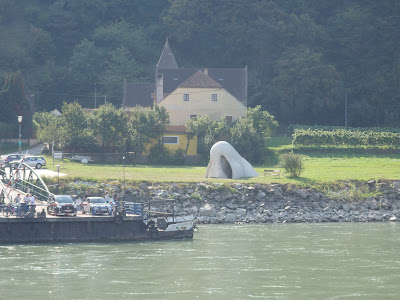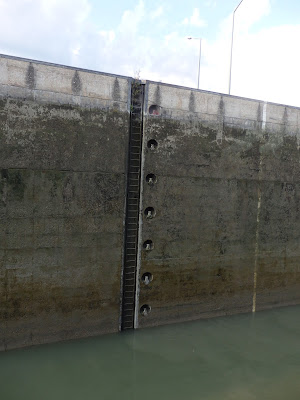 |
| Trucks in Europe are all cab-over instead of conventional like in the states. |
 |
| Swan gliding over the Danube |
 |
| This bridge is low enough that the awnings needed to be lowered. |
 |
| Austrian scenes along the river |
 |
| Entering the Wachau Valley, a UNESCO World Heritage site. There are no bridges in this area. |
 |
| Dürnstein, Austria |
 |
| Burgruine Dürnstein, the ruin of a castle where Richard the Lion-hearted of England was held by Leopold V, Duke of Austria, in 1192, overlooks Stift Dürnstein. |
 |
| A statue of King Richard and his faithful servant Blondell |
 |
| The vines draped in blue netting are set aside to make ice wine, a type of dessert wine produced from grapes that have been frozen while still on the vine |
 |
| The Wachau Valley is also know for its apricots, which are grown on the banks of the Danube just like the grapes. |
 |
| Pfarrkirche Weißenkirchen |
 |
| The car ferry at St. Lorenz, Austria has an interesting shelter/sculpture called The Wachauer Nase. A good nose is essential in a wine-growing area. |
 |
| Spitz, Austria's late gothic church to St. Maurice is famous for its Apostles and altarpiece |
 |
| Car ferry at Spitz |
 |
| Hinterhaus, a 13th century fortress |
 |
| It was time for the emergency drill so we all ran (ok walked) to our rooms for our life vests then assembled in the lounge |
 |
| Ship's crew with their emergency equipment |
 |
| Melk Abbey at Melk, Austria was founded in 1089 when Leopold II, Margrave of Austria gave one of his castles to Benedictine monks. |
 |
| Entering Melk Abbey. The Baroque abbey you see today was built between 1702 and 1736. |
 |
| View of Melk from the Abbey. We were not allowed to take photos inside the Abbey. |
 |
| The confluence of the Melk River and the Danube |
 |
| Main Street Melk |
 |
| The main shopping area didn't allow cars except for this little bus. The bollards would sink into the street so the bus could get through. |
 |
| Another view of Melk Abbey |
 |
| The River Adagio docked at Melk |
 |
| Regulations require that the ship be up against a side of the lock so here's the Captain working diligently to get the ship positioned correctly. |
 |
| Looking back as the lock doors began to close, I could see Melk Abbey. |
 |
| Last look at the abbey before the doors close |
 |
| When I said the ship had to be up against the lock walls, I meant it. |
 |
| There were seven hooks visible when we got settled into the lock. |
 |
| Up to the next level |
 |
| Hey Melk Abbey became visible again. |
 |
| Melk Abbey and the locks |








No comments:
Post a Comment